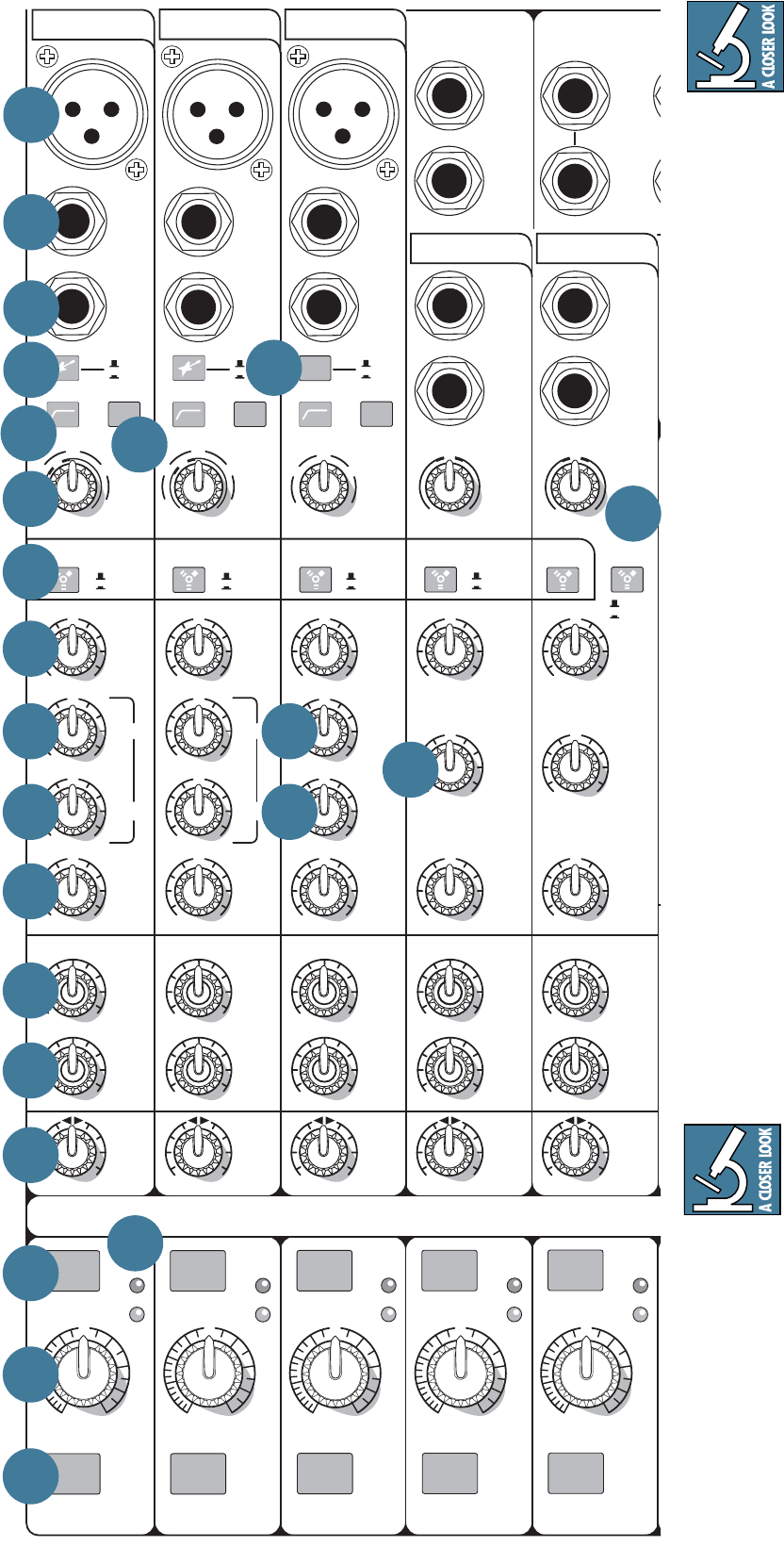
18 Onyx 820i
Plugging a guitar into a lower-impedance
line-level input
can result in the loss of high
frequencies, causing an unnatural and dull
sound.
Normally, you must use a direct box
between a guitar and a mixer’s input, which serves to
convert the impedance of the guitar from high to low.
The hi-z inputs on channels 1 and 2 make the need for
a direct box unnecessary. However: The hi-z inputs are
unbalanced (when the switch is in), so if you’re doing a
live show and running a long cord between the
instrument and the mixer (say over 25 or 30 feet), it is
best to use a direct box with a balanced output to avoid
picking up noise over the length of the cord.
19. LOW CUT (Ch.1–4 only)
The mono and hybrid channels each have a low-cut
switch (often referred to as a high-pass fi lter) that cuts
bass frequencies below 75 Hz at a rate of 18 dB per
octave.
For channels 1 and 2, the low cut switch affects the
mic and line inputs. For channels 3 and 4, it affects the
mic input only.
We recommend that you use low-cut on every
microphone application except kick drum, bass guitar,
or bassy synth patches. These aside, there isn’t much
down there that you want to hear, and fi ltering it out
makes the low stuff you do want much more crisp and
tasty. Not only that, but low-cut can help reduce the
possibility of feedback in live situations, and it helps to
conserve amplifi er power.
Another way to consider low-cut’s function
is that it actually adds fl exibility during live
performances. With the addition of low-cut,
you can safely use low equalization on vocals.
Many times, bass shelving EQ can really benefi t voices.
Trouble is, adding low EQ also boosts stage rumble, mic
handling clunks and breath pops from way-down low.
Applying low-cut removes all those problems, so you can
add low EQ without blowing your subwoofers.
20. 48V PHANTOM POWER (Ch. 1-4 only)
Most modern professional condenser mics require
48V phantom power, which lets the mixer send low-
current DC voltage to the mic’s electronics through the
same wires that carry audio. (Semi-pro condenser mics
often have batteries to accomplish the same thing.)
“Phantom” owes its name to an ability to be “unseen”
by dynamic mics (Shure SM57/SM58, for instance),
which don’t need external power and aren’t affected by
it anyway.
Press this switch in if your microphone requires
phantom power. (Always check the position of this
switch before connecting microphones.)
MUTE
SOLO
48V
MUTE
SOLO
48V
MUTE
SOLO
48V
LINE
MUTE
SOLO
MUTE
SOLO
PAN
2
1
MID
FREQ
MID
FREQ
BAL/UNBAL BAL/UNBAL
ALT 3-4 ALT 3-4 ALT 3-4 ALT 3-4 ALT 3-4
LOW
MID
400Hz
O
N
Y
X
M
I
C
P
R
E
HIGH
12kHz
LOW
80Hz
EQ
INSERT INSERT
O
N
Y
X
M
I
C
P
R
E
HIGH
12kHz
LOW
80Hz
EQ
O
N
Y
X
M
I
C
P
R
E
HIGH
12kHz
HIGH
MID
2.5KHz
LOW
80Hz
EQ EQ
(MONO)
L
R
L
(MONO)
R
BAL/UNBAL
L
(MONO)
R
BAL/UNBAL
L
(MONO)
R
BAL/UNBAL
AUX RET
U
1
1
2
AUX SEND
MID
2.5kHz
LOW
80Hz
U
+15-15
U
+15-15
U
+15-15
U
+15-15
U
+15-15
U
+15-15
U
+15-15
U
+15-15
U
+15-15
U
+15-15
U
+15-15
U
+15-15
U
+15-15
U
+15-15
U
+15-15
U
+15-15
HIGH
12kHz
MID
2.5kHz
LOW
80Hz
HIGH
12kHz
FW 1-2
LINE
HI
-
Z
LINE
-10dB
+
4dB
HI
-
Z
LINE
PRE
POST
PRE
POST
PRE
POST
PRE
POST
LEVELLEVELLEVEL LEVEL LEVEL
+10dB
OO
U
+10dB
OO
U
+10dB
OO
U
+10dB
OO
U
+10dB
OO
U
1 2 3-4
LINE IN 5-6 LINE IN 7-8
AUX
PAN
2
1
AUX
PAN
2
1
AUX
PAN
2
1
AUX
PAN
2
1
AUX
OL
- 20
OL
-
20
-
20
OLOL
-
20
OL
-
20
12
BAL/UNBAL BAL/UNBA
L
SEND SEND SEND SEND
SEND INPUT
3-4 5-6 7-8
GAIN
+20dB-20dB
U
GAIN
MIC
GAIN
GAIN
+20dB-20dB
U
U
20
30
40
60
+40dB
U
-20dB
U
20
30
40
60
GAIN
+40dB
U
-20dB
U
20
30
40
60
1
LINE
2
LINE
1k
100 8k
1k
100 8k
MAX
OO
MAX
OO
MAX
OO
MAX
OO
MAX
OO
MAX
OO
MAX
OO
MAX
OO
MAX
OO
MAX
OO
LR LR LR LR LR
18. HI-Z SWITCH (Ch. 1 and 2 only)
Engage this switch if you want to connect guitars
directly to the 1/4" line inputs of channels 1 or 2.
Without this switch, you need to use a DI box fi rst,
before connecting guitars. If these switches are not
pressed in, guitars will not sound good, particularly the
high frequency response.
8
9
10
18
19
20
23
24
25
26
27
31
32
33
34
35
36
37
38
28
29
30
21
22


















